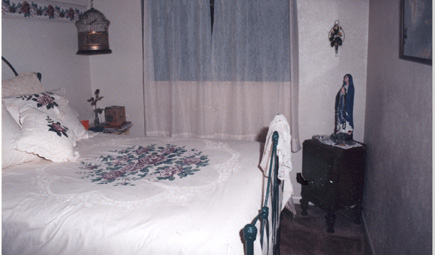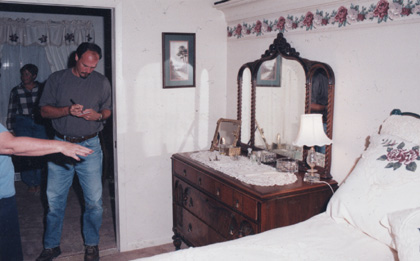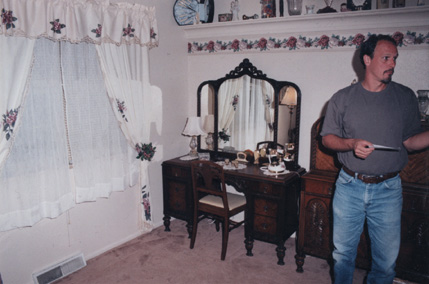 |
 |
Location:
Private House in Colorado
Date: July
of 2000
Weather: calm
warm (80's) night
Equipment used:
digital thermometers, 35mm cameras, emf meters,
& audio recorders
Contacts:
Bryan Bonner and Christopher J. Williams
Website:http:.//www.rockymountainparanormal.com
Email:bryan@rockymountainparanormal.comor
chris@rockymountainparanormal.com

Our investigation into “The Friendly Farmer” consisted of a lengthy interview, a site survey and taking photographs. This process is then followed by extensive research into the history and background of the property.
Initial contact is made by phone. We ask very brief questions about the phenomenon that is being experienced, who has witnessed this and their family situation. This aids us in preparing a list of questions to be asked at the interview. After a date and time is set to meet with the percipient we at R.M.P.R.S. than edit our sample questionnaire to adjust it to the conditions of each particular situation.
The interview is the most important part of an investigation. It defines the parameters, helps determine the regularity (if any), and establishes a sequence to the event. The most critical aspect is that we develop a sense of trust and professionalism with the interviewee. We always tape record the interview. This provides a record of what was asked and the responses that can latter be used to reconstruct, as accurately as possible, the phenomenon.
This specific
case illustrates the importance of the interview. What was determined was;
1) The appearances
were random and separated by long periods of inactivity.
2) The appearances
were specific to one area of the house.
3) No auditory
phenomenon was noted.
4) Some clues
were present to establish an identity to the ghost, ie. He looked like
a farmer; she wore clothes from the 30’s or 40’s.
5) There was
no kinetics noted, ie. Slamming doors or objects moving.
6) The percipient
felt that they were sad.
7) Information
on the informants cultural background.

R.M.P.R.S. then conducted a survey of the house and reviewed the area of the phenomenon. We did not notice any cold spots or any energy surges. A rough drawing was made of the layout and approximate locations of the apparitions were noted. We took photographs of the rooms in hopes that maybe something would turn up.
Because of the random nature of these ghosts it was highly unlikely that any activity would be captured on film or otherwise. Before leaving we ask the percipient to keep a log of any future activity. It should be pointed out that this request usually proves to be disappointing. The client either looses interest or forgets to enter pertinent data. We recognize hat this is valuable information to be collected but is almost impossible to expect or mandate that a client participate at a level we deem necessary. We are currently evaluating how we can make this a user-friendly system of data gathering.

Due to the lack of documentable evidence we are usually faced with the need to find corroborative proof. This is where the long and laborious task of research comes into play. First we go to the County Assessors and pull copies of all the deeds pertinent to the property. This gives us names and dates to track down the history of the owners. From here we check census records. This gives some background information such as age, occupation and marital status. We also check marriage and divorce records and newspaper obituaries. If a previous owner is still alive we try to track down their current location and call them to ask if they ever noticed supernatural activities while living there. Like a detective we are searching for leads that could explain and substantiate what the client perceived.
As you can imagine this process takes a very long time and the majority of the information leads to dead ends. We still are acquiring and investigating leads on this property. What we have found out is the following:
1) This was never
farm property per-se. It was speculative real estate held from the 1900
to 1970’s by various people in hope that it would increase in value. It
was developed, subdivided and homes built on it, including our subject
house, in 1971. None of the owners lived on the property during that period,
however that does not mean it was not subleased to farmers.
2) Between 1971
and 1993 the house was sold 5 times. Of these, two “quit claims” were filed
that put the house in a spouse’s name due to divorce. The original selling
price was $24,000, however, in 1988 the property was transferred for $6,000.
Looks suspicious and we are still trying to track down this owner but it
looks like he left the state. Also an interesting note…his ex-wife remarried
one month after the divorce and we have not been able to find her anywhere.
Her new husband remarried again but there is no record of their divorce.
Did she die? We are still searching the obituaries.
3) One
owner only owned the house for 3 months and resold it. I tracked
him down and talked to him but it turned out he never lived there.
It was a real estate deal to buy the house turn around and sell it quick.
Some of the conclusions that can be drawn are that the client is stable and reliable. She seems to have witnessed something that she is convinced is paranormal. It appears that (according to current theory) that the “farmer” ghost could be a residual ghost. Although the fact that he did reach out and touched her makes a precise classification difficult. The other ghostly forms are residual ghosts due to the fact that they did not interact at all. The percipient did perceive that they were sad and tried to comfort them. This perceived attribute would indicate that these spirits came to an unhappy ending. We are hopeful that this can be verified by researching the various local periodicals.
This is a brief
summary to highlight some of the steps we go through to investigate the
paranormal. We intended to show the procedures, the information gathering
process, some of the drawbacks and frustrations. Research into the paranormal
is not a science. It is a theory at best. We at the Rocky Mountain
Paranormal Research Society like to take the approach analogous to
preparing a case to be tried in court. Most evidence collected is circumstantial,
it implicates our position that paranormal activity exists but does not
prove it beyond reasonable doubt. The best we can do is keep compiling
as much evidence as possible. It is always worth remembering that
you can still prove your case if the preponderance of circumstantial evidence
is overwhelming and corroborative.
© 2000 davejuliano@theshadowlands.net
© 2000 Rocky Mountain Paranormal Research Society